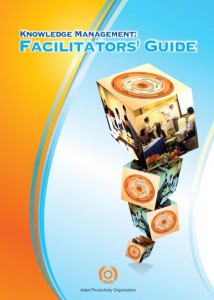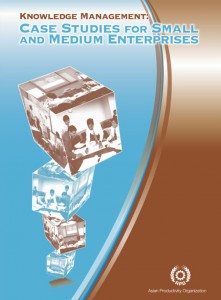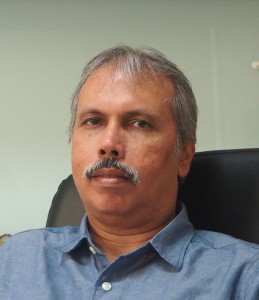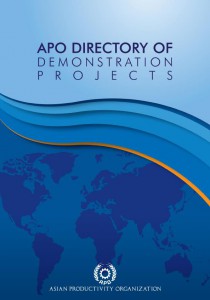
Select Page

Knowledge management (KM) first gained a foothold in large organizations in the mid-1990s. Today, its benefits are recognized by governments, the education and service sectors, and SMEs alike. The Asia-Pacific region is blessed with numerous KM proponents, and the APO News invited four who have worked extensively with the APO to participate in a virtual roundtable discussion. PN Nair (PN) is principal consultant on KM and change management at KDi Asia, an international consulting organization based in Singapore, and was a key architect of the APO KM framework. As a long-time KM consultant for many international organizations, Dr. Serafin Talisayon (ST) writes, teaches at the University of the Philippines, and speaks on the topic worldwide. Dr. IY Yasin (IY) has worked at the Malaysia Productivity Corporation for over 20 years and serves as the Industrial Advisor for the KM Program at the Multimedia University of Malaysia. Her research interests focus on KM and productivity measurement. Ron Young’s (RY) work with the ISO committee developing a KM standard, as well as years of KM consultancy for both the private sector and UK government, give depth and breadth to his comments.
APO News: In layman’s terms, explain why KM is as important for SMEs as for large organizations including public-sector ones.

Dr. Serafin Talisayon
ST: SME managers or owners have a simple objective: to increase sales and revenues. If they do not see how a KM initiative can help them achieve this, they will reject it outright. This forces the KM consultant to go back to the basics: where and how can KM create value for the SME? In bigger organizations, KM consultants can get away with supply-driven KM approaches, such as storytelling, knowledge inventory, social network analysis, and knowledge sharing that are not demand driven. In SMEs, consultants must start with an area of KM that is not popular: understanding and using customer knowledge. This has the most direct bearing on SME sales and revenues.
![]()
RY: First, we need to clarify what type of SME it is. In today’s knowledge-driven economy, an increasing number of SME startups are very knowledge intensive, e.g., software developers, technology developers, and creative designers and developers. KM is a fundamental part of what they do, as knowledge is their primary resource as knowledge workers. If the SME is not as knowledge intensive, such as a more manual manufacturing company, the need for KM is different. It needs to know the needs of customers, markets, etc. and KM helps them focus on this.![]()
In both cases, SMEs can benefit enormously from managing their knowledge better to help them grow their businesses and innovate faster, as opposed to large companies that have fragmented knowledge and do not know what they know.

Dr. Ida Yasin
IY: Knowledge is rapidly becoming the most important asset of all organizations, and SMEs are no exception. SMEs need to manage knowledge for the same reasons as larger organizations. They will gain a competitive advantage through their ability to manage and exploit knowledge. To remain competitive, SMEs must first know what their knowledge assets are, then how to manage and make use of them for maximum return. KM can be a strategic weapon for SMEs to develop more sustainable, superior business practices, making them less vulnerable to economic cycles.
Government organizations worldwide are facing challenges as legislative, executive, and judicial bodies continue to evolve into an electronic work environment pushed by paperwork and cost reduction mandates, increased workloads with fewer personnel, and the rapid addition of electronic communication channels for use by taxpayers and citizens. Governments are often the first to need to adopt new approaches to electronic information management. KM tools are increasingly recognized by governments as strategic resources within the public sector. Some of the common challenges that affect the public sector worldwide include enhancing efficiency in public agencies, improving accountability, making informed decisions, enhancing collaboration and strategic partnerships with stakeholders, capturing the knowledge of an aging workforce, and achieving operational excellence.
 APO News: Give tips on how to determine where an organization stands with regard to KM implementation. RY: The APO has an excellent publication entitled Knowledge Management: Facilitators’ Guide. This contains assessment tools and questions to ask to determine where an organization, regardless of size, is in KM maturity.
APO News: Give tips on how to determine where an organization stands with regard to KM implementation. RY: The APO has an excellent publication entitled Knowledge Management: Facilitators’ Guide. This contains assessment tools and questions to ask to determine where an organization, regardless of size, is in KM maturity.
PN: One of the questions that organizations should ask is, “Are we losing knowledge as a result of staff attrition?” If the answer is yes, it is an indication that they do not have a proper system of capturing the collective knowledge of employees. In many cases, organization have some form of KM initiative although they may not explicitly call it KM. APO News: Describe some of the major challenges in undertaking and maintaining a KM initiative as well as how they can be overcome.
 RY: These are also documented in the APO publication Knowledge Management: Case Studies for Small and Medium Enterprises. PN: A major challenge is sustaining the KM momentum. Many organizations start off well and then lose the initial enthusiasm. When there is a change in leadership, early KM efforts may not be carried on or there may be a change in focus and direction APO News : What do you think has been the APO’s contribution to propagating KM in the Asia-Pacific? Has it been successful in applying KM to the productivity arena?
RY: These are also documented in the APO publication Knowledge Management: Case Studies for Small and Medium Enterprises. PN: A major challenge is sustaining the KM momentum. Many organizations start off well and then lose the initial enthusiasm. When there is a change in leadership, early KM efforts may not be carried on or there may be a change in focus and direction APO News : What do you think has been the APO’s contribution to propagating KM in the Asia-Pacific? Has it been successful in applying KM to the productivity arena?
ST: KM came to Asia-Pacific countries via local subsidiaries of multinational corporations with KM programs, bilateral and multilateral donor and development financing agencies such as the Asian Development Bank (ADB) which introduced or required KM in their local projects, and intergovernmental agencies such as the APO, SEAMEO, and PEMSEA. The contribution of the APO is through the NPOs, which generally reached government agencies, the development sector, and SMEs. The free downloadable KM publications of the APO were useful to these sectors.
KM supports the productivity agenda of the APO because the two objectives of KM are productivity and innovation. However, the APO must develop a single workable framework that integrates both KM/IC management and productivity/quality management. However, after participants in APO KM workshops, study meetings, and other learning events return to their workplaces, they do not always apply what they learned according to their superiors who were surveyed or interviewed. This stems from the fact that course topics are determined from the top during the Workshop Meetings of Heads of NPOs) and courses are offered to participants without the assurance that they are in fact needed in their workplaces (courses are APO supply driven instead of participant organizations’ demand driven).
Unlike the ADB, the APO has not yet moved from firm-level (or organizational-level) KM to national-level KM. What policies and strategies can a national government adopt to achieve greater national competitiveness in a global knowledge economy? The World Bank developed tools for a “knowledge-based economy” (KBE), and the ADB approaches to “knowledge-based development” (KBD) much earlier.

Ron Young
RY: The APO has done some outstanding work in KM awareness and education. Many NPOs and companies across Asia have good KM awareness. The next important step is to turn that awareness into successful implementation, and, most importantly, to be able to see increased knowledge work productivity. I believe that the NPOs and APO need to now start implementing a collective form of KM both themselves and in companies in each APO member.
It is impossible to promote KM effectively through awareness and education alone. It is essential for all to perform KM in daily work, benefit from it, and then help others perform it successfully.
Most importantly, the APO has the vision of becoming the international leader in productivity enhancement. As vital as manual productivity enhancement will continue to be, especially Green Productivity, the APO now needs to promote knowledge productivity. I always quote Professor Peter Drucker on this from Management Challenges for the 21st Century: “The greatest contribution management made in the 20th century was to increase the productivity of manual working fifty-fold…. The greatest contribution management needs to make for the 21st century is to similarly increase the productivity of knowledge working.”
APO News: Based on your experience of working with APO member countries, how would you describe the level and extent of adoption of KM in different countries? Which countries have achieved significant progress and what can other countries do to gain KM momentum? Give examples, if possible.
ST: Competitiveness has shifted from the productivity arena to the innovation arena. Here, Singapore is one of the leaders. When it changed its NPO to “SPRING” more than a decade ago, the Singapore government showed that it had recognized early that KM for innovation is as important, or perhaps more important than, KM for productivity.
RY: The most advanced are the ROC, India, Japan, the ROK, and Singapore; Malaysia and Thailand are advanced; and Indonesia is rapidly emerging.
APO News: What can and should NPOs do to promote KM in their countries and how could the APO help them?
IY: NPOs should implement KM themselves. To promote KM, they can offer KM consultancy services to the private and public sectors. The APO can help NPOs by providing a knowledge-sharing platform, community of practice, and expert services. Some of these have been introduced to a certain extent.
PN: For NPOs to promote KM, they must have competence in KM. The current reality is that not all member countries have that capability. It is therefore necessary for the APO to help build the capacity of NPOs. Only then can they promote KM in their countries. We need to move from awareness to competence. Just as the capability of NPOs in implementing productivity and quality programs was developed in the past, the capability to undertake KM programs needs to be to be built up.
APO News: Could you share an interesting personal experience where KM made a difference to an organization?
ST: An SME in the printing business was having problems with delayed deliveries of end products to customers, threatening its reputation for reliability. It was difficult for the owner to physically check the status of each of more than 20 ongoing job orders, each involving about 30 steps from customer inquiry to delivery of the end product. Its production area occupied two floors of a big building. The solution proposed and implemented by a senior manager was to set up an online Google Docs where every staff involved in a process updates the status of the step he/she is responsible for 24/7 and flags potential issues. A short (15–30-minute) “lessons learned” session is held after each delivery, whether successful or delayed. The tool is simple, inexpensive, and the SME owner-manager is very happy with it.
RY: I personally worked on an APO demonstration project, with the NPC, India, for BEL India, part of the Ministry of Defence. The results made a big difference to BEL and this is fully documented in the 2015 APO publication APO Directory of Demonstration Projects.
IY: I introduced KM to an organization, but unfortunately most of the staff were reluctant to come onboard. There was no buy-in. Then I decided to use the APO KM Framework to start KM initiatives without them realizing that they were KM. After a few months, we saw small achievements and some staff were happy to share success stories. The strategy is, start with the low-hanging fruit. Then I explained KM again, citing the example of small achievements. The staff were then more receptive to KM. A few tips: 1) They do not know? Inform. 2) They are not able? Educate and train. 3) They are not willing? Convince. 4) They do not believe? Build trust.

Praba Nair
PN: I have worked on several KM projects. One of the most interesting was the Application of KM and Innovation for Community Development in the Tea Plantation Sector in Sri Lanka. This required the involvement of the NPO, tea plantations, district hospital, and Plantation Human Development Trust. The project focused on identifying the knowledge gaps of healthcare providers and recipients of the preventive and curative maternal healthcare services in the estate sector to reduce maternal deaths. Positive results have been seen in better health and the estate community taking ownership of health and well-being.
APO News: Give an example of a non-APO member country where KM is widely practiced and describe some of the achievements.
RY: KM has been widely practiced around the world since the 1990s. The best source for companies practicing effective KM would be The Most Admired Knowledge Enterprises list published since 1998. This information is also available from the American Productivity and Quality Center (APQC).
PN: Besides America and Europe, there are many successful stories of KM in Australia, New Zealand, and Africa. One interesting case is the use of KM in the agriculture sector in Western Australia. The integration of farmers’ knowledge and precision agricultural tools based on crop simulation modeling provided management options for poor-performing patches. The results showed the value of leveraging farmers’ knowledge in decisions about field management.
APO News: What is your view on the future of KM in Asia and globally?
 ST: KM is beset by several issues: 1) There is no commonly agreed or accepted set of standards. 2) Since KM started in the business sector instead of the academic sector, practice is ahead of theory. 3) The word “knowledge” is defined differently by KM gurus compared with standard dictionaries such as Merriam-Webster, leading to much confusion. 4) It overlaps greatly with other fields such as IT, human resources, and quality management. 5) Alignment of KM with organizational objectives is not given enough attention and may even be disrupted by KM models based on the knowledge cycle or maturity stages, which often have no direct linkage to organizational targets. Nevertheless, a PhD dissertation concluded that KM was not a fad. KM publication numbers have exploded since 1990 and continue to do so. The consensus among several KM experts is: the term KM may disappear in the future, but managing knowledge is here to stay because of the simple reality that the global economy is largely a knowledge economy (three-fourths of GWP is from knowledge; only one-fourth is from extraction and processing of natural resources).
ST: KM is beset by several issues: 1) There is no commonly agreed or accepted set of standards. 2) Since KM started in the business sector instead of the academic sector, practice is ahead of theory. 3) The word “knowledge” is defined differently by KM gurus compared with standard dictionaries such as Merriam-Webster, leading to much confusion. 4) It overlaps greatly with other fields such as IT, human resources, and quality management. 5) Alignment of KM with organizational objectives is not given enough attention and may even be disrupted by KM models based on the knowledge cycle or maturity stages, which often have no direct linkage to organizational targets. Nevertheless, a PhD dissertation concluded that KM was not a fad. KM publication numbers have exploded since 1990 and continue to do so. The consensus among several KM experts is: the term KM may disappear in the future, but managing knowledge is here to stay because of the simple reality that the global economy is largely a knowledge economy (three-fourths of GWP is from knowledge; only one-fourth is from extraction and processing of natural resources).
RY: Most organizations, globally and in Asia, have embarked on what I refer to as “operational KM,” i.e., incrementally improving the way they manage their knowledge within existing structures. What is lacking, is strategic KM, which is looking at KM not incrementally but in a transforming way that will make a big difference in helping organizations achieve their vision and objectives and make then far more knowledge driven.
This requires a more focused approach to KM, referred to as “knowledge asset Management.” Knowledge cannot be measured, but knowledge assets certainly can. The ISO is working on a KM standard, and I hope to be part of the discussions, on behalf of the British Standards Institution, to help influence the standards on knowledge asset management and knowledge working productivity.
In my opinion, this will be the key enabler to enhancing productivity in an increasingly global knowledge-driven economy. More focus should be on SMEs, the engines of our future.
APO News: Finally, please suggest some important references that would enhance readers’ understanding of KM.
RY: All the related APO publications are excellent references, covering the APO KM Framework, methodology for practitioners, case studies in Asia, tools and techniques, and KM for the public sector.
PN: There is a list of recommended books on KM in the APO’s Knowledge Management: Facilitators’ Guide.